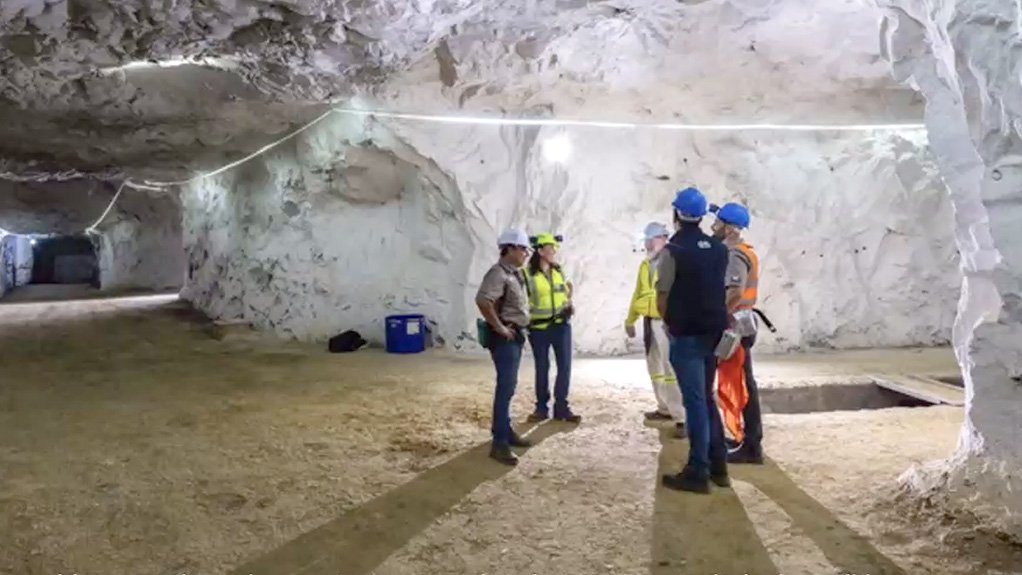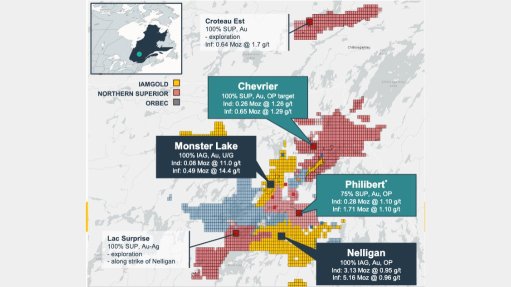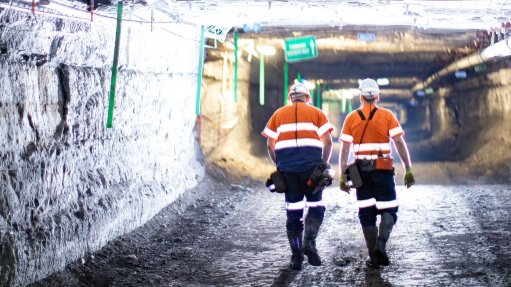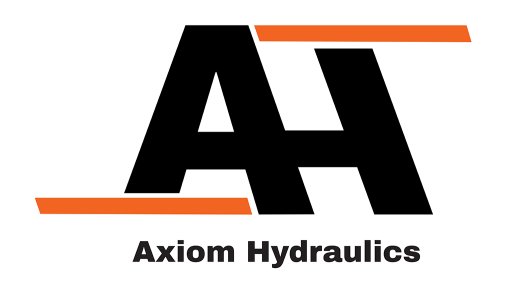Green copper, vapour refining envisaged at Orion’s Northern Cape base metals mines
JOHANNESBURG (miningweekly.com) – Green copper and clean smelting and refining are envisaged at Orion Minerals’ quickly advancing base metals mines in South Africa’s well-endowed Northern Cape province, which has historically produced 2.5-millon tons of copper until base metal mining ceased there several decades ago.
The fully permitted and already reviving Prieska mine will begin producing its first saleable copper and zinc 12 to 18 months after finalising its total funding requirement, which is estimated at from R3-billion to R4-billion.
“First focus was to prove the ore. We've done that. Second focus was do the bankable studies; we've done that. Third is build the mines and produce concentrates that are saleable, and then the fourth one will be putting those concentrates in a local smelter or refinery,” Orion CEO Errol Smart said during a South Africa-Australia webinar covered by Mining Weekly.
Regarding Orion putting up a smelter, Smart said: We would lean away from smelting. We've done a lot of work on metal vapour refining. We're doing a lot of work on hydrometallurgical leaching.
“We would prefer to go away from energy-intensive smelting. It's difficult to build an environmentally friendly smelter, but it is quite viable to build an environmentally friendly metal vapour refinery or leach plant, and that's what we will probably look at in the future. We've got a whole team working on that. We're looking at the optimised case,” he said during question time.
Renewable energy is on the cards: “We’re in advanced discussions with a few renewable energy power producers and one is offering 90% certified renewable energy at a cost 20% lower cost than the Eskom supply cost.
“So, essentially, we will be producing certified green copper on our side. That's a huge opportunity and when speaking to the offtakers and debt financiers that green, ESG, credibility is very important,” he emphasised.
Power utility Eskom is scheduled to turn on the mine’s 15 MW of electricity input next Wednesday.
Trial mining has been under way for some time, with drilling and blasting taking place daily, and about 30 000 t of ore is already on surface.
The existing shaft, which descends to 1 100 m, has multiple underground roadways that reach down to the deepest ore at 1 250 m.
Orion has been conducting bankable studies since 2019 and is putting the finishing touches to updated versions.
Mine chambers at Prieska, which were blasted in the 1970s, have held their ground and no meshing and lacing, nor rock anchors, are required.
“This ground is standing fantastically well and what we've proven is that in the area where we're going to mine, we can put in big machines, we can get economies of scale, and we can get the mining happening,” said Smart.
“We can run 4.5 m by 4.5 m development ends, and we can get efficiency in scale of mining.
“We've also proven that we can handle events of nature, a one-in-100-year rainfall event.
“We've put flood control measures in place, and we've shown that there will not be no unplanned flooding.
“The nine-billion cubes of water in the mine must be pumped out and the pumps to do this have been put in place,” said Smart.
The construction of a water retention dam will be completed in the next few months and the reverse osmosis plant is scheduled to be in place next year as an additional water control measure.
A 15 MVA grid power supply system has been constructed and 4 km dual water and tailings pipeline has been established to the tailings facility.
Besides Prieska, the Johannesburg Stock Exchange- and Australia Stock Exchange-listed Orion is also advancing the Okiep copper project, which has produced nearly two-million tons of copper historically under previous Newmont and AngloVaal ownership.
These projects are gaining strong momentum at an ideal time in a district that has produced at an average grade of 1.9% copper. For many decades, it produced more than 20 000 t/y of copper from the existing plant facilities.
At Okiep, which is known for its high grades, Orion drilled one of the highest-grade intersections that has been drilled in the world, 50 m at 5% copper.
“There’s high-grade ore here that hasn't been mined, and we’ll be proving it as we go,” he said.
Okiep is awaiting a water right and sign off on the engineering design of the tailings facility.
"Over the last nine years, Orion has done a consolidation of the most prospective brownfields projects and many of the best greenfields areas. We've put that together over here, and those are the projects moving forward."
The company has spent this year finalising optimised feasibility studies, while 160 people are active on site at Prieska, where having plants in place and production commencing at the end of next year is envisaged.
“There are very few opportunities in the world where there are mines that are fully permitted, they can come into production in 12 to 18 months, and they've got a big growth profile in front of them, and that's where we are.
“This Prieska mine is a brownfields project. It was a large mine in its time. It used to have a processing plant with a capacity of three-million tons a year. It processed very successfully, produced very good concentrate. There are a lot of knowns and a lot of the infrastructure was in place, and that's what's helping us to accelerate this project,” Smart outlined.
The historic mining happened in ore that was dipping towards the north-east. At about 950 m depth, the orebody suddenly goes to a reversal and it dips to the south-west, and it becomes very flat dipping. That's historically where AngloVaal stopped mining. AngloVaal mined from 105 m below surface to 970 m below surface.
There were 42 known mines in the district, more than three-quarters of them on Orion properties.
There are 1 700 outcropping mafic orebodies that could have ore, and about 200 of those have got copper showings.
These are some of the questions put to Smart by webinar attendees:
Who was appointed to do the bankable feasibility studies for Prieska and Okiep?
Bearing in mind that we've been running these bankable studies since 2019 and have a lot of bankable feasibility study experience, we decided not to go to any one of the engineering companies and get a cut-and-paste job, which is what you very often see. So, we have got ten contributing independent contractors and consultants into each of the bankable feasibility studies. The project management of coordinating the ten independent consultants is done by our own in-house team, which has pulled it all together. But it really is just a coordination job. All the work is done by independent experts, and they're the big names.
When can we expect to see first production?
First production is 12 to 18 months from financing. Financing will partly depend on bank approvals. We talk about bankable feasibility studies, but there's no definition of what a bankable feasibility study is. A bankable feasibility study is a feasibility study that one or other debt financier has accepted or a group of debt financiers have accepted, to provide debt financing. The reality is that we'll probably have a plus minus 10% to 15% feasibility study complete in six weeks’ time. We may well publish that and make it available, and we are already in discussion under confidentiality with a lot of finance organisations. Most importantly, the offtakers are playing an increasingly important role in financing of mining projects worldwide, and we are in discussions with offtakers, on offtake terms and potentially to provide financing. Those that provide financing will get preferential attention on the offtake as we go forward. We expect about six months of dealing with the financing. We may get underway earlier with the construction, with some of the parties that we are speaking about, but the final elements of the financing will probably take about six months and then 12 months of construction. But at Prieska we are physically mining and stockpiling ore today, so it is a mine, it just doesn't have a concentrator yet.
The South African rand is also projected to strengthen in the coming weeks and how would this, as well as the better South African sentiment, affect your projects?
That's actually a very interesting question. When you are going into construction, the best thing that you could possibly ask for is a strong currency. The producers now prefer to have a weaker currency, because they’re earning their revenue in dollars that are converted into rand, and they are repatriating it in rands and reporting their profits and their profit margins in rand. When you're going into acquisition and construction, many items are bought offshore, such as machines, diesel, oil, tyres, transport costs that are large during the construction phase. All those items are very sensitive to the rand and having a strong rand is an absolute dream and it’s the best thing that we could ask for as we go into acquiring machines. Most of our financing will be done in South Africa, so we will be financing predominantly in rands. We'll be spending rands to build but we will need to convert those rands to euros and dollars and to yuan to buy our capital goods. So, we're very happy that we've got a strong currency at the moment, and also just for stability. The banking world wants to see stability, and they don't want a lot of volatility. The rand volatility over the last week has all been on the best side, it's a strengthening of the rand that has been good. But volatility sometimes creates an uncertainty that we have to factor in. But, at the moment, it's all going in our favour.
Is Orion still on track for the first sale of copper at the end of 2025?
In 18 months from now, I think there's a very strong reality that that will happen from Prieska. At Okiep, it's touch and go. I think that might push into 2026 but Prieska is on track to be in production at the end of 2025.
What are you doing to manage blackouts and power shortages?
That's also an interesting thing that's changed. South Africans will be aware that Minerals Council South Africa and Business for South Africa have got very involved in assisting the government and the parastatal institutions in improving the power supply problem. We've just gone through 85 days now without any power blackouts. We've had the best power security in the last three months than what we've probably had in the last five years. It’s improving and it’s improving strongly. South Africa’s new Government of National Unity, I would imagine, is going to be more supportive of private institution involvement and that takes a lot of the volatility risk out of it. The other thing that has been very important is independent power producers and particularly renewable energy power producers. Producing certified green copper is a huge opportunity and when speaking to the offtakers and debt financiers that green, ESG, credibility is very important. With all those things coming together, we're in a very good state. We have put a megawatt of standby diesel generation on site, and we may put a little bit more, but right now, for the last four months, we haven't been affected by power outages, and we think that we'll be in a good position to maintain that very high energy supply.
What is the procurement process for becoming an improved vendor and criteria for selection?
We've been building since 2018. In South Africa, when you speak about local procurement, it's South African procurement. Then the next year is provincial procurement from the province of the Northern Cape, and then the key tier is local, as in our host community. So, we've been working with our host community to build that procurement arrangement. It is complicated. There are elements of some people wanting to get unfair access to tenders. We cannot and we will not give unfair tender awards to people, but some of our best suppliers are from the local host community. A host community company is installing our power, and they've done fantastic work for us. Fifty-three per cent of our catering staff are from our local community, where there's been no mining since 1991. We’ve put a lot of pressure on all our suppliers to have a local depot and employ local staff in the depot. Our contractors are encouraged to use local staff in part of their procurement. We encourage women involvement in mining. We wouldn't have got access to the Triple Flag financing unless we had high ESG standards. It's a work in progress. It's never over. We've got to continue building capacity. But we are getting there, and it's very good. Our website outlines a supplier preregistration opportunity to local suppliers.
Is there a smooth handover between the exploration, construction and operational teams?
This is probably one of the things that we've been most successful with. We drew down on the first financing from IDC and Triple Flag in November last year. The beauty of going through a trial mining startup is before we have a concentrator and come under pressure to have product for sale, we've gone through all the teething pains. We've had a 12-month handover from the exploration team to the mining team. The mining team is now completely recruited. The exploration team are hardly involved. Both Okiep and at Prieska are in the hands of the mining teams that are site resident and operated. We've had nine months of going through that with teething pains. Not everybody that we employed survived. Some people have had to be replaced, but we've done that before being measured on our daily outcomes. Any mine startup has got a lot of problems, we've gone through them, we've solved them, we've proved them, and we can show people the outcomes and we derisk the projects by doing that.
Have you considered capital raising to unlock the full funding?
Eventually we're going to have to do a capital raise. Everybody knows that there's a capital raise coming at some time. It will happen when we've negotiated a good deal with the right future shareholders. For Prieska, we are very close to making a final decision on what we need and were probably three months away from knowing exactly the quantum we’ll need at Okiep. We’re in discussion with several potential equity funders, and when we find accord with them, we will come back and offer it to our existing shareholders in parallel, so we won't exclude the current shareholders and even our retail shareholders. Everybody will get a chance to participate on the same terms. Nobody will be excluded.
How much funding will Prieska need to commence production?
Realistically, it's going to be somewhere between probably A$250-million to A$300-million. Let's say R3-billion to R4-billion is the total funding requirement. Of that, equity will probably be around 30% because we've got the $80-million Triple Flag financing for Prieska lined up. We're in discussions with debt financiers, offtake-related financiers, and with several build, own, operate, transfer concerns on the processing plant. The total ticket, the mix of financing, is being finalised as we speak, and when we finally know what it is, we will go. We are getting a lot of inquiries. The good election outcome has been fantastic for us.
What were some of the higher copper grade deposits mined at Okiep historically?
The Okiep mine was a brilliant mine. It mined about 900 000 t at 21% copper. It was a very high grade mine. There were several mines at 5% to 10% copper for smaller tonnages. In the historic reports, the mines show what they milled, but generally they had big teams of ladies to do ore sorting by hand. They had these big tables that they used to pass the ore over, and women would line up and sort the ore by hand, because women have got a better sense of texture and colour; they all see better than men. It's a genetic fact. Now, modern technology allows us to do it with scanners, and the world of artificial intelligence is a lot more efficient. We're doing a lot of work on sorting and we showed with that very high-grade hole that we drilled that we could produce a 10% copper concentrate that could go to our mill. There is the ability to sort out the waste. That's a key thing at Okiep, particularly. There's a lot of internal waste and the choice is putting it into a big mill at low grade or sorting out the waste and putting the higher-grade ore in the mill.
Article Enquiry
Email Article
Save Article
Feedback
To advertise email advertising@creamermedia.co.za or click here
Press Office
Announcements
What's On
Subscribe to improve your user experience...
Option 1 (equivalent of R125 a month):
Receive a weekly copy of Creamer Media's Engineering News & Mining Weekly magazine
(print copy for those in South Africa and e-magazine for those outside of South Africa)
Receive daily email newsletters
Access to full search results
Access archive of magazine back copies
Access to Projects in Progress
Access to ONE Research Report of your choice in PDF format
Option 2 (equivalent of R375 a month):
All benefits from Option 1
PLUS
Access to Creamer Media's Research Channel Africa for ALL Research Reports, in PDF format, on various industrial and mining sectors
including Electricity; Water; Energy Transition; Hydrogen; Roads, Rail and Ports; Coal; Gold; Platinum; Battery Metals; etc.
Already a subscriber?
Forgotten your password?
Receive weekly copy of Creamer Media's Engineering News & Mining Weekly magazine (print copy for those in South Africa and e-magazine for those outside of South Africa)
➕
Recieve daily email newsletters
➕
Access to full search results
➕
Access archive of magazine back copies
➕
Access to Projects in Progress
➕
Access to ONE Research Report of your choice in PDF format
RESEARCH CHANNEL AFRICA
R4500 (equivalent of R375 a month)
SUBSCRIBEAll benefits from Option 1
➕
Access to Creamer Media's Research Channel Africa for ALL Research Reports on various industrial and mining sectors, in PDF format, including on:
Electricity
➕
Water
➕
Energy Transition
➕
Hydrogen
➕
Roads, Rail and Ports
➕
Coal
➕
Gold
➕
Platinum
➕
Battery Metals
➕
etc.
Receive all benefits from Option 1 or Option 2 delivered to numerous people at your company
➕
Multiple User names and Passwords for simultaneous log-ins
➕
Intranet integration access to all in your organisation



















